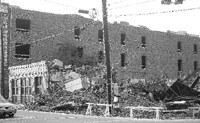Joe Riley would be glad to know that the owner of the downtown Blue Monkey — destroyed in a fire earlier this month — plans to rebuild. And it’s not that he’s a fan of the restaurant’s crisps or the Friday meatloaf special. Instead, Riley values historic buildings — the one that housed the Monkey was built in 1900 — and takes his vacant lots and dilapidated buildings seriously.

The site of the downtown Blue Monkey, which burned down earlier this month.
“To ruin a whole block, it just takes one building,” he said at a Friends for Our Riverfront-sponsored lecture last week at Bridges Inc.
Riley is an eight-term mayor credited with breathing new life into Charleston. Under his leadership, Charleston changed from a stagnating Southern city into one alive with possibilities: The city experienced a downtown revitalization, a decrease in serious crime, the opening of Waterfront Park in 1990, and an artistic renaissance.
“It’s all about making a better place to live,” he said. “That sounds trite maybe, but a human being is in a better community if there’s a beautiful public ground to be inspired by. They’re in a better community if the city is safer; a better community if downtown isn’t desolate but is restored and has arts and playgrounds.”
Riley has used his authority from the street level up. In one case, a building gutted by fire was slated to be demolished. Even though it lacked structural integrity, Riley had the historic building restored, and it emerged as a catalyst, transforming the surrounding area into a hot commercial district.
“Every time we unnecessarily tear something down, we forever, forever, take away a memory for the community,” he said. “We need the … sense of place.”
Riley and Charleston are a pair that Memphis and Shelby County could learn from. If the two cities aren’t sisters, they’re definitely cousins.
Riley defined a great city as a place that “poor people and rich people love the same.” He puts a premium on beauty for that reason, saying that there’s never any excuse, especially when the government is involved, to build something that doesn’t add beauty to a city.
“People often wonder why [we worked so hard to restore downtown]. It’s not the tax base. That’s important. It’s not the jobs. That’s important. It’s the public realm. [Downtown] is part of the city that everyone owns,” said Riley. “If we let them go, then every citizen has lost something.”
During the restoration of an art deco theater, Riley wanted to include storefronts and a wider sidewalk. City officials objected, saying they couldn’t narrow the street because beer trucks often parked there to make deliveries. If the street were narrowed, other trucks and buses might have a problem getting through.
“So often in an American city, we say, ‘Let’s take care of the beer truck,’ when the real issue is how does the mother feel holding their child’s hand and walking down the street? How does the citizen feel?” Riley said. “The beer truck will find a place to park.”
That same sense of public ownership came into play when the city began the controversial Waterfront Park project, started after plans were unveiled for a dense commercial and residential development on the same site.
“Of course it was controversial,” said Riley. “Parks cost money; they take land off the tax base. When you design a park, one of the hardest things you do is to understand what is the purpose of the park. For this park, we knew its purpose was to be an inspirational, reposeful place for people in a busy city.” Now, people can’t imagine Charleston without it.
For a city to undergo Charleston’s phoenix-like transformation, it takes a lot of planning, attention to detail, and a coordinated vision. Certain things — such as sampling 50 kinds of gravel for a walkway to find the right color — could be construed as ridiculous, but in the end, add to the city’s character.
The trick, of course, is separating what’s really going to make a difference and what isn’t. And in Memphis, where sometimes single items or events are promoted as the way to put the city on the map, we are wise to be wary.
Near the beginning of his talk, Riley showed a slide of an old hotel and said it illustrated how the city had made a big mistake.
“In the ’50s, [they demolished] the historic Charleston Hotel where the Democratic Convention met in 1860,” he said. “One of our most beautiful buildings was demolished because they knew that to be a great city, you had to have a drive-in motel.”